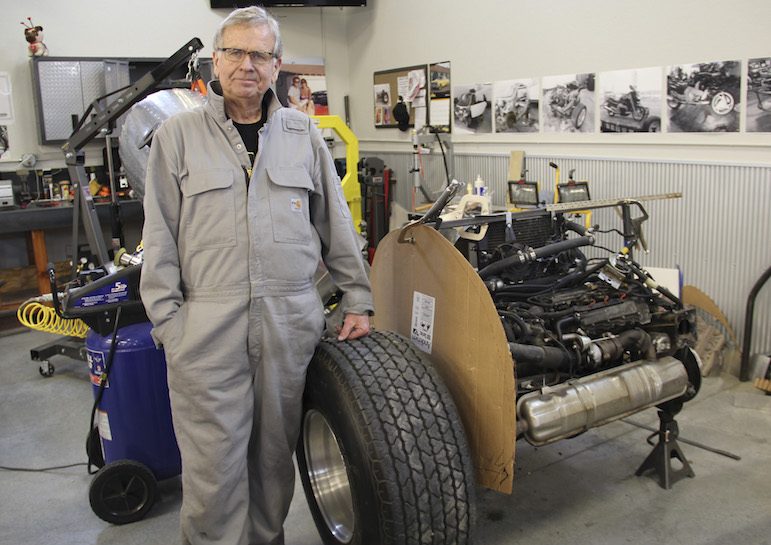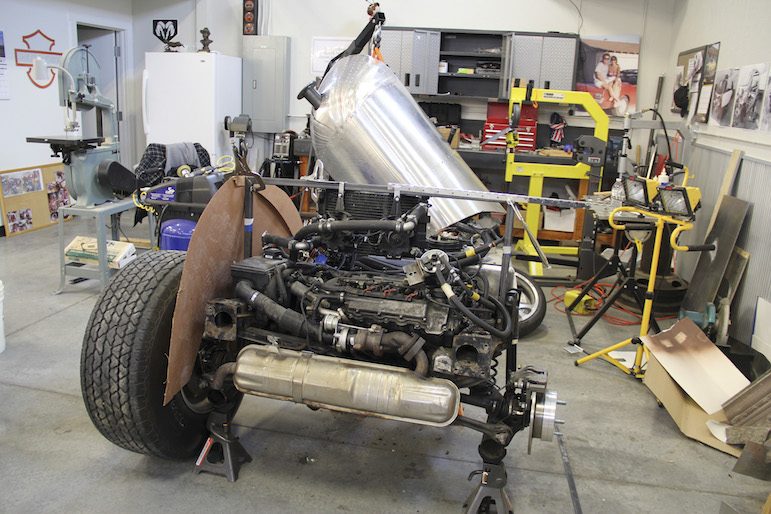A gear head’s pistons never stop pumping

Ed Kemmick/Last Best News permalink
Kent Harris stands beside the Smart Car engine and one tire of the back end of his motorized trike. Behind him is the aluminum cabin the driver will sit in. Click on the arrow at top right for more photos.

Ed Kemmick/Last Best News permalink
Here, when it was still in one piece, is the trike Harris is working on now, minus the aluminum body.
Ed Kemmick/Last Best News permalink
Harris checks out the aluminum body that encloses the driver and most of the front end.

Ed Kemmick/Last Best News permalink
Here's another look at the trike engine, with the aluminum body behind it.
Kent Harris took Walt Disney’s words to heart: “If you can dream it, you can do it.”
Gear Head Land was not in the headlights for Harris in his youth. And the retired banker admits that he was never really much of a motorcycle or car guy. He had, and does own, some nice wheels, but he had never gone in for the nitty-gritty part—the dirty, oily hands, scratched-up knuckles and sleepless nights thinking about projects.
Then, nearly four years ago, at age 68, he was visited with a dreamy idea: to build a turbo -charged, diesel-powered motorized trike. Not a standard dream, and not close to a standard motorized trike. Heck no. He wanted to build something special, different and original. Something where none of rules apply. A trike that no one else has. No one.
That original idea spawned another one, that he would build a trike to set a new land speed record at Bonneville Speedway in Utah.
Since coming up with the idea, Harris has traveled nearly every day back and forth from Absarokee, where he lives, to a shop-warehouse in Laurel owned by Dean Rankin. The shop is a gear head’s dream. The ultimate man cave. TV. Lots of room. Tools. Well heated and lit. Elk mounts on the walls. A family picture pin-up. A fridge. Triumph motorcycles in various stages of restoration. Full-dressed Harleys and Hondas ready to ride. Only one drip of oil could be found on the floor. A panoramic photo of the original Butte Motorcycle Club sits over the workbench and work area.
As for the motorized trike, well, it progresses and changes, and then, as Harris says, “as I work through it,” it changes again, and again.
Initial studies led to the idea that a three-cylinder turbo-charged diesel engine from a 2004 Smart Car could serve as the engine and powertrain. Connect that section with a 1993 Yamaha 1000 GTS with an open hub fork for the front end and shazzam! Like magic, this unique ride would roll from the clean grey floors and cruise the Montana backroads.
But mechanical mantras like “as I work through it” have minds of their own.
The initial build was completed and running. Harris drove it. He decided that the feel and lines of his new trike weren’t to his liking. It had too high a center of gravity. You sat up too straight in the seat. It looked like other trikes. It had a windshield. It steered like other trikes. Other things grated him, too, and eventually he scrapped the original build and went back to the drawing board.
He studied Carver and Clever three-wheel-vehicle mechanisms to get ideas and decided on a hydraulic tilting mechanism of his own design. Worked like the rudder pedals in an airplane, the front half of the trike will be able to lean into curves at up to a 45 degree angle, while the rear wheels stay firmly on the road, providing stability and control. Like flying down the road with the feel and lean of a two-wheel motorcycle.

Kent Harris
The new design included a tubular frame that was built to attach the front fork, suspension, rudder pedals, handlebars, controls and seat. It is much lower to the ground than the first go-around and far more aerodynamic. It has a sleek airplane-like look.
Then, using a shrinker-stretcher tool, aluminum sheets were cut, formed and riveted together and to the frame, creating an enclosed cabin for the driver. It is very tight quarters.
My big question was: What about the land speed record angle of building the trike?
Harris explained that it is very difficult to fit his trike into a category that currently exists at the Bonneville Speedway. There are many levels and types of vehicles, he said, and fitting his trike into one of those would be agonizingly burdensome. He admits that, after talking to Bonneville, if the record was a priority, he should have built it to a specific category.
His build is too unique. He hopes, someday, to bring his trike for a run on the salt flats. He also recognizes that however fast it is, even if it’s only in the 50-mph range, it could be enough of a self-accomplishment, and established just as easily on old Highway 10.
Harris describes himself as a seeker. He has, throughout his life, searched and practiced a variety of thoughts and philosophies to provide insights and escapes from the daily grind. This project is another example of his need to follow a somewhat mystical path.
“What I like the most is that there are no rules to this project,” Harris said. “I can do what I want.” And, aside from some fundamentals of physics—and Montana statutes to make this project street legal—it is obvious that the creativity built into this trike came from that early dream and Harris’ hard work.
Car and bike guys with dreams aren’t from Fantasyland. Rather, they are driven by a vision, mechanical ability and the tenacity to “work through” a project.
Kent Harris and his trike would make Walt Disney smile.
Comments
comments








